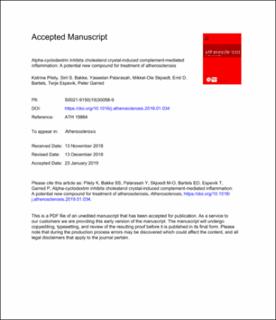| dc.contributor.author | Pilely, Katrine | |
| dc.contributor.author | Bakke, Siril Skaret | |
| dc.contributor.author | Palarasah, Yaseelan | |
| dc.contributor.author | Skjoedt, Mikkel-Ole | |
| dc.contributor.author | Bartels, Emil D. | |
| dc.contributor.author | Espevik, Terje | |
| dc.contributor.author | Garred, Peter | |
| dc.date.accessioned | 2020-03-26T12:10:08Z | |
| dc.date.available | 2020-03-26T12:10:08Z | |
| dc.date.created | 2019-03-20T21:45:21Z | |
| dc.date.issued | 2019 | |
| dc.identifier.citation | Atherosclerosis. 2019, 283 35-42. | en_US |
| dc.identifier.issn | 0021-9150 | |
| dc.identifier.uri | https://hdl.handle.net/11250/2648870 | |
| dc.description.abstract | Background and aims
Cholesterol crystal (CC)-induced inflammation is a critical step in the development of atherosclerosis. CCs activate the complement system and induce an inflammatory response resulting in phagocytosis of the CCs, production of reactive oxygen species (ROS) and release of cytokines. The cyclodextrin 2-hydroxypropyl-β-cyclodextrin has been found to reduce CC-induced complement activation and induce regression of established atherosclerotic plaques in a mouse model of atherosclerosis, thus inhibition of complement with cyclodextrins is a potential new strategy for treatment of inflammation during atherosclerosis. We hypothesized that other cyclodextrins, like α-cyclodextrin, may have related functions.
Methods
The effect of cyclodextrins on CC-induced complement activation, phagocytosis, and production of ROS from granulocytes and monocytes was investigated by flow cytometry and ELISA.
Results
We showed that α-cyclodextrin strongly inhibited CC-induced complement activation by inhibiting binding of the pattern recognition molecules C1q (via IgM) and ficolin-2. The reduced CC-induced complement activation mediated by α-cyclodextrin resulted in reduced phagocytosis and reduced ROS production in monocytes and granulocytes. Alpha-cyclodextrin was the most effective inhibitor of CC-induced complement activation, with the reduction in deposition of complement activation products being significantly different from the reduction induced by 2-hydroxypropyl-β-cyclodextrin. We also found that α-cyclodextrin was able to dissolve CCs.
Conclusions
This study identified α-cyclodextrin as a potential candidate in the search for therapeutics to prevent CC-induced inflammation in atherosclerosis. | en_US |
| dc.language.iso | eng | en_US |
| dc.publisher | Elsevier | en_US |
| dc.rights | Attribution-NonCommercial-NoDerivatives 4.0 Internasjonal | * |
| dc.rights.uri | http://creativecommons.org/licenses/by-nc-nd/4.0/deed.no | * |
| dc.title | Alpha-cyclodextrin inhibits cholesterol crystal-induced complement-mediated inflammation: A potential new compound for treatment of atherosclerosis. | en_US |
| dc.type | Peer reviewed | en_US |
| dc.type | Journal article | en_US |
| dc.description.version | acceptedVersion | en_US |
| dc.source.pagenumber | 35-42 | en_US |
| dc.source.volume | 283 | en_US |
| dc.source.journal | Atherosclerosis | en_US |
| dc.identifier.doi | 10.1016/j.atherosclerosis.2019.01.034 | |
| dc.identifier.cristin | 1686523 | |
| dc.relation.project | Norges forskningsråd: 223255 | en_US |
| dc.description.localcode | © 2019. This is the authors’ accepted and refereed manuscript to the article. Locked until 3 February 2020 due to copyright restrictions. This manuscript version is made available under the CC-BY-NC-ND 4.0 license http://creativecommons.org/licenses/by-nc-nd/4.0/ | en_US |
| cristin.unitcode | 194,65,15,0 | |
| cristin.unitname | Institutt for klinisk og molekylær medisin | |
| cristin.ispublished | true | |
| cristin.fulltext | original | |
| cristin.fulltext | postprint | |
| cristin.qualitycode | 1 | |

